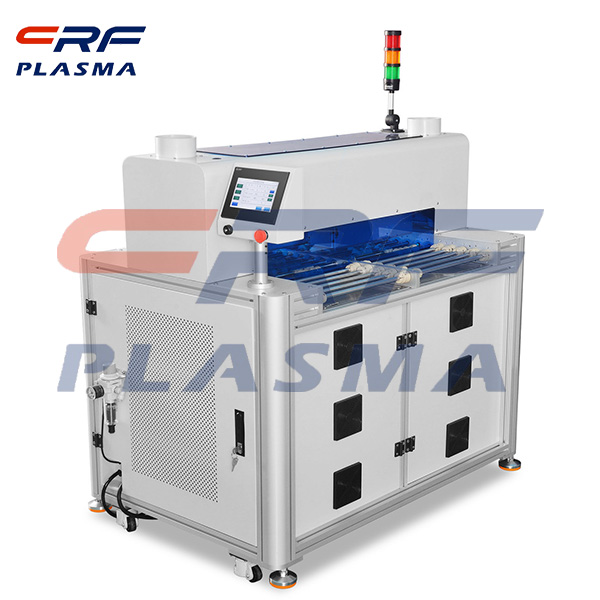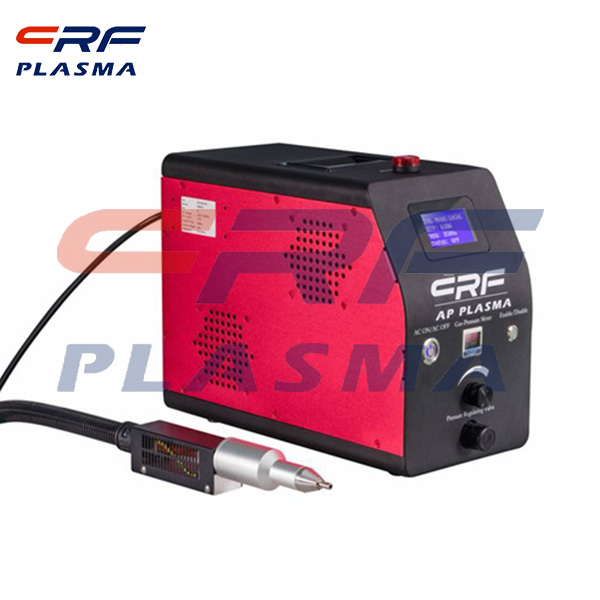
Welcome to Shenzhen Sing Fung Intelligent Manufacturing Co., Ltd.
E-mail:shaobo@sfi-crf.com
Plasma carbon nanotubes are modified for pollutant monitoring and treatment
- Categories:Technical Support
- Author:plasma cleaning machine-surface treatment equipment-CRF plasma machine-Sing Fung Intelligent Manufacturing
- Origin:
- Time of issue:2021-04-16
- Views:
(Summary description)Plasma modification is a new process with short treatment time, no chemical pollution, no damage to the overall volume structure of materials, and only change the surface properties of materials. In recent years, the institute of plasma of low temperature plasma application laboratory, Chen Changlun, shao dong, polly, wang and other research using the low temperature plasma technology for surface cleaning of carbon nanotubes modified assembly, overcome the carbon nanotubes from the difficult solubility limit, greatly improve the level of its practical application. Carbon nanotubes (CNTs) have been modified and assembled by low temperature plasma technology, and a series of achievements have been made in the detection and treatment of environmental pollutants. Ar/H2O,Ar/NH3 and Ar/O2 microwave plasma were used to treat the surface of carbon nanotubes, and functional groups containing oxygen and amino were introduced into the nanotubes to improve their hydrophilicity and make them into nanosolutions. These functionalized materials have a good application prospect for improving the biosorption and environmental adsorption of carbon nanotubes. Applied Physics Letter (2010, 96, 131504); Carbon (2010, 48, 939-948); The Journal of Physical Chemistry C (2009, 113, 7659-7665); Some of the results were published in Diamond & Related Materials (in press). Two oral reports were also invited to the meeting. Secondly, the surface of carbon nanotubes was activated by N2 radiofrequency plasma, and the organic monomers and natural polymers were grafted onto the surface of carbon nanotubes to prepare carbon nanotubes/organic composite. The surface of composite materials prepared by isoionization system contains a variety of functional groups, which have strong adsorption and complexation effect on persistent organic pollutants (POPs), toxic and harmful heavy metal ions, radionuclides, etc., thus improving the ability of composite materials to adsorb pollutants. Some results were published in The Journal of Physical Chemistry B (2009, 113, 860-864). Chemosphere (2010, 79, 679-685); Plasma Processes and Polymers (in press, and selected for cover). Due to the small size of carbon nanotubes (CNTs), it is difficult to recycle and reuse the organic/inorganic pollutants after adsorption. Conventional centrifugal method requires high speed, and filtration method is easy to cause filter membrane blockage, carbon nanotubes adsorbed pollutants into the environment, easy to cause secondary pollution. In order to solve the problem above, using the sol-gel method is a new type of nanometer materials, the material on the carbon nanotube assembly feng up the iron oxide, and then use N2 rf plasma activation/ferrite on the surface of carbon nanotubes, upper grafting organic monomer and natural macromolecular materials, was prepared with multiple composite magnetic nano materials, not only adsorption performance is good, In addition, magnetic separation technology can easily separate magnetic composite nanomaterials from solution, which solves the problem of difficult solid-liquid separation, and can be applied to practical work on a large scale.
Plasma carbon nanotubes are modified for pollutant monitoring and treatment
(Summary description)Plasma modification is a new process with short treatment time, no chemical pollution, no damage to the overall volume structure of materials, and only change the surface properties of materials. In recent years, the institute of plasma of low temperature plasma application laboratory, Chen Changlun, shao dong, polly, wang and other research using the low temperature plasma technology for surface cleaning of carbon nanotubes modified assembly, overcome the carbon nanotubes from the difficult solubility limit, greatly improve the level of its practical application.
Carbon nanotubes (CNTs) have been modified and assembled by low temperature plasma technology, and a series of achievements have been made in the detection and treatment of environmental pollutants.
Ar/H2O,Ar/NH3 and Ar/O2 microwave plasma were used to treat the surface of carbon nanotubes, and functional groups containing oxygen and amino were introduced into the nanotubes to improve their hydrophilicity and make them into nanosolutions. These functionalized materials have a good application prospect for improving the biosorption and environmental adsorption of carbon nanotubes. Applied Physics Letter (2010, 96, 131504); Carbon (2010, 48, 939-948); The Journal of Physical Chemistry C (2009, 113, 7659-7665); Some of the results were published in Diamond & Related Materials (in press). Two oral reports were also invited to the meeting.
Secondly, the surface of carbon nanotubes was activated by N2 radiofrequency plasma, and the organic monomers and natural polymers were grafted onto the surface of carbon nanotubes to prepare carbon nanotubes/organic composite. The surface of composite materials prepared by isoionization system contains a variety of functional groups, which have strong adsorption and complexation effect on persistent organic pollutants (POPs), toxic and harmful heavy metal ions, radionuclides, etc., thus improving the ability of composite materials to adsorb pollutants. Some results were published in The Journal of Physical Chemistry B (2009, 113, 860-864). Chemosphere (2010, 79, 679-685); Plasma Processes and Polymers (in press, and selected for cover).
Due to the small size of carbon nanotubes (CNTs), it is difficult to recycle and reuse the organic/inorganic pollutants after adsorption. Conventional centrifugal method requires high speed, and filtration method is easy to cause filter membrane blockage, carbon nanotubes adsorbed pollutants into the environment, easy to cause secondary pollution. In order to solve the problem above, using the sol-gel method is a new type of nanometer materials, the material on the carbon nanotube assembly feng up the iron oxide, and then use N2 rf plasma activation/ferrite on the surface of carbon nanotubes, upper grafting organic monomer and natural macromolecular materials, was prepared with multiple composite magnetic nano materials, not only adsorption performance is good, In addition, magnetic separation technology can easily separate magnetic composite nanomaterials from solution, which solves the problem of difficult solid-liquid separation, and can be applied to practical work on a large scale.
- Categories:Technical Support
- Author:plasma cleaning machine-surface treatment equipment-CRF plasma machine-Sing Fung Intelligent Manufacturing
- Origin:
- Time of issue:2021-04-16 10:37
- Views:
Plasma carbon nanotubes are modified for pollutant monitoring and treatment:
Plasma modification is a new process with short treatment time, no chemical pollution, no damage to the overall volume structure of materials, and only change the surface properties of materials. In recent years, the institute of plasma of low temperature plasma application laboratory, Chen Changlun, shao dong, polly, wang and other research using the low temperature plasma technology for surface cleaning of carbon nanotubes modified assembly, overcome the carbon nanotubes from the difficult solubility limit, greatly improve the level of its practical application.

Carbon nanotubes (CNTs) have been modified and assembled by low temperature plasma technology, and a series of achievements have been made in the detection and treatment of environmental pollutants.
Ar/H2O,Ar/NH3 and Ar/O2 microwave plasma were used to treat the surface of carbon nanotubes, and functional groups containing oxygen and amino were introduced into the nanotubes to improve their hydrophilicity and make them into nanosolutions. These functionalized materials have a good application prospect for improving the biosorption and environmental adsorption of carbon nanotubes. Applied Physics Letter (2010, 96, 131504); Carbon (2010, 48, 939-948); The Journal of Physical Chemistry C (2009, 113, 7659-7665); Some of the results were published in Diamond & Related Materials (in press). Two oral reports were also invited to the meeting.
Secondly, the surface of carbon nanotubes was activated by N2 radiofrequency plasma, and the organic monomers and natural polymers were grafted onto the surface of carbon nanotubes to prepare carbon nanotubes/organic composite. The surface of composite materials prepared by isoionization system contains a variety of functional groups, which have strong adsorption and complexation effect on persistent organic pollutants (POPs), toxic and harmful heavy metal ions, radionuclides, etc., thus improving the ability of composite materials to adsorb pollutants. Some results were published in The Journal of Physical Chemistry B (2009, 113, 860-864). Chemosphere (2010, 79, 679-685); Plasma Processes and Polymers (in press, and selected for cover).
Due to the small size of carbon nanotubes (CNTs), it is difficult to recycle and reuse the organic/inorganic pollutants after adsorption. Conventional centrifugal method requires high speed, and filtration method is easy to cause filter membrane blockage, carbon nanotubes adsorbed pollutants into the environment, easy to cause secondary pollution. In order to solve the problem above, using the sol-gel method is a new type of nanometer materials, the material on the carbon nanotube assembly feng up the iron oxide, and then use N2 rf plasma activation/ferrite on the surface of carbon nanotubes, upper grafting organic monomer and natural macromolecular materials, was prepared with multiple composite magnetic nano materials, not only adsorption performance is good, In addition, magnetic separation technology can easily separate magnetic composite nanomaterials from solution, which solves the problem of difficult solid-liquid separation, and can be applied to practical work on a large scale.
Scan the QR code to read on your phone

TEL:0755-3367 3020 / 0755-3367 3019

E-mail:sales-sfi@sfi-crf.com

ADD:Mabao Industrial Zone, Huangpu, Baoan District, Shenzhen

















